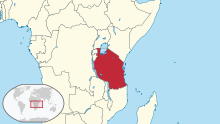Acanthopale laxiflora
| Acanthopale laxiflora | |
|---|---|

| |
| Scientific classification | |
| Kingdom: | Plantae |
| Clade: | Tracheophytes |
| Clade: | Angiosperms |
| Clade: | Eudicots |
| Clade: | Asterids |
| Order: | Lamiales |
| Family: | Acanthaceae |
| Genus: | Acanthopale |
| Species: | A. laxiflora
|
| Binomial name | |
| Acanthopale laxiflora | |

| |
| Tanzania in its region | |
Acanthopale laxiflora is a weak shrub growing up to two meters tall with woody stems. It is usually grown as an ornamental plant.[1] It grows primarily in the wet tropical biome.
Description[edit]
Within the lush confines of Tanzania's Lushoto District, nestled amid the majestic Usambara Mountains' Magamba Forest, flourishes an intriguing botanical specimen.[2] This shrubby herb or soft-wooded shrub, attaining heights of up to 2 meters, features young stems adorned with distinctive wings and occasional appressed hairs at the nodes. Its foliage, characterized by an ovate to elliptic shape, measures between 6.5 and 18.5 cm in length and 2.5 to 7 cm in width for larger leaves. Notable for its acuminate to cuspidate apex and attenuate base, the foliage bears sporadic hairs along the midrib and veins beneath, with a modest array of hairs gracing the upper lamina.
During its reproductive phase, elongated racemes, extending up to 16 cm in length, adorn the plant, boasting winged peduncles and short pedicels. The calyx, measuring between 7 and 12 mm, typically exhibits a glabrous or sparsely sericeous appearance, adorned with linear lobes. The corolla, cloaked in pristine white hues with a regal purple throat or streaks therein, boasts sparse hairiness along a narrow dorsal band.[3]
Ecologically, this botanical marvel thrives in the damp embrace of evergreen montane forests, flourishing at altitudes ranging from 1800 to 2300 meters. Despite superficial similarities to the West African A. decempedalis, nuanced variations in bract and calyx indumentum set it apart. Notably, the plant has been observed to contribute to mass flowering events and subsequent diebacks, as evidenced on Mt. Kilimanjaro during the years 1992 and 1993. While its distribution remains limited to this region, its presence enriches and diversifies Tanzania's botanical landscape.[4]
Reference List[edit]
- ^ "Acanthopale laxiflora - Useful Tropical Plants". tropical.theferns.info. Retrieved 2024-03-03.
- ^ "Acanthopale laxiflora (Lindau) C.B.Clarke | Plants of the World Online | Kew Science". Plants of the World Online. Retrieved 2024-03-03.
- ^ "Record: Herbarium:K000394196 | Occurrence record | Royal Botanic Gardens, Kew". data.kew.org. Retrieved 2024-03-03.
- ^ "ACANTHOPALE laxiflora C. B. Clarke [family ACANTHACEAE] on JSTOR". plants.jstor.org. Retrieved 2024-03-03.
